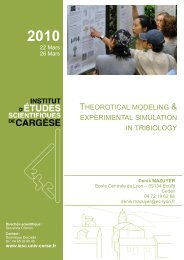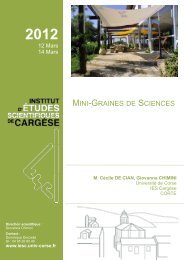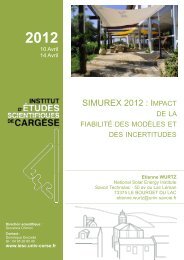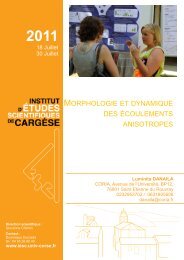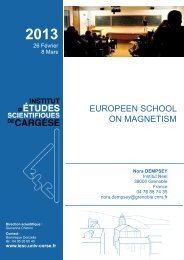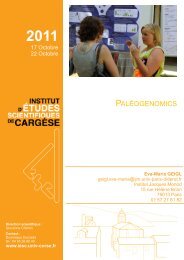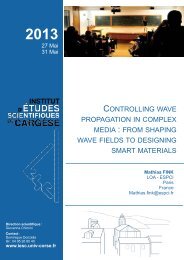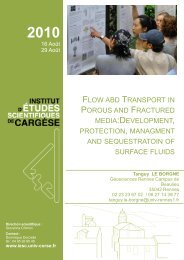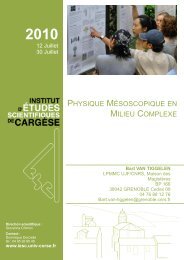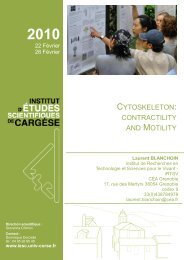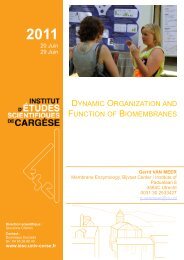nanoelectronics - Institut d'Études Scientifiques de Cargèse (IESC)
nanoelectronics - Institut d'Études Scientifiques de Cargèse (IESC)
nanoelectronics - Institut d'Études Scientifiques de Cargèse (IESC)
You also want an ePaper? Increase the reach of your titles
YUMPU automatically turns print PDFs into web optimized ePapers that Google loves.
Thursday<br />
Electronic standing waves on the surface of the topological insulator Bi 2 Te 3<br />
P.Rakyta 1 , A.Pályi 2 , J.Cserti 1<br />
1 Department of Physics of Complex Systems, Eötvös University, H-1117 Budapest, Pázmány<br />
Péter sétány 1/A, Hungary<br />
2 Department of Materials Physics, Eötvös University, H-1117 Budapest, Pázmány Péter<br />
sétány 1/A, Hungary<br />
A line <strong>de</strong>fect on a metallic surface induces standing waves in the electronic local <strong>de</strong>nsity of<br />
states (LDOS). Asymptotically far from the <strong>de</strong>fect, the wave number of the LDOS oscillations<br />
at the Fermi energy is usually equal to the distance between nesting segments of the Fermi<br />
contour, and the envelope of the LDOS oscillations shows a power-law <strong>de</strong>cay as moving<br />
away from the line <strong>de</strong>fect. Here, we theoretically analyze the LDOS oscillations close to a<br />
line <strong>de</strong>fect on the surface of the topological insulator Bi 2 Te 3 , and i<strong>de</strong>ntify an important<br />
preasymptotic contribution with wave-number and <strong>de</strong>cay characteristics markedly different<br />
from the asymptotic contributions. The calculated energy <strong>de</strong>pen<strong>de</strong>nce of the wave number of<br />
the preasymptotic LDOS oscillations is in quantitative agreement with the result of a recent<br />
scanning tunneling microscopy experiment [1].<br />
[1] Z.Alpichshev, J.G.Analytis, J.-H.Chu, I.R.Fisher, Y.L.Chen, Z.X.Shen, A.Fang and<br />
A.Kapitulnik, Phys. Rev. Lett. 104, 016401 (2010)<br />
__________________________________________________________________________<br />
How does Exact DFT compares with exact solutions in simple mo<strong>de</strong>ls of strongly<br />
correlated electrons ?<br />
Jaime Ferrer, Diego Carrascal<br />
Departamento <strong>de</strong> Física, Universidad <strong>de</strong> Oviedo<br />
We present analytic expressions for the exact <strong>de</strong>nsity functional and Kohn-Sham<br />
Hamiltonian of simple tight-binding mo<strong>de</strong>ls of correlated electrons. These are the single- and<br />
double-site versions of the An<strong>de</strong>rson, Hubbard and spinless fermion mo<strong>de</strong>ls. The exact<br />
exchange and correlation potentials keep the full non-local <strong>de</strong>pen<strong>de</strong>nce on electron<br />
occupations. The analytic expressions allow to compare the Kohn-Sham eigenstates of exact<br />
<strong>de</strong>nsity functional theory with the many-body quasi-particle states of these correlate<strong>de</strong>lectron<br />
systems. The exact Kohn-Sham spectrum <strong>de</strong>scribes correctly many of the non-trivial<br />
features of the many-body quasi-particle spectrum, as for example the precursors of the<br />
Kondo peak. However, we find that some pieces of the quasi-particle spectrum are missing<br />
because the many-body phase-space for electron and hole excitations is richer [1].<br />
[1] D. Carrascal and J. Ferrer, Phys. Rev. B 85 045110 (2012)



